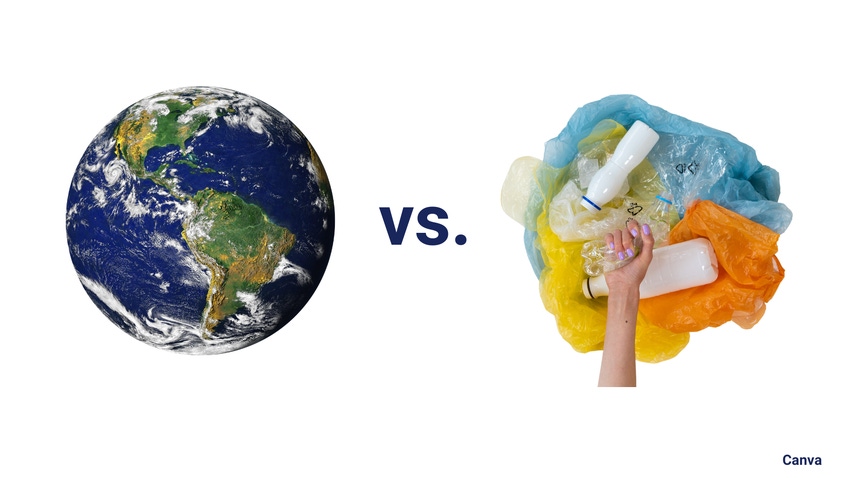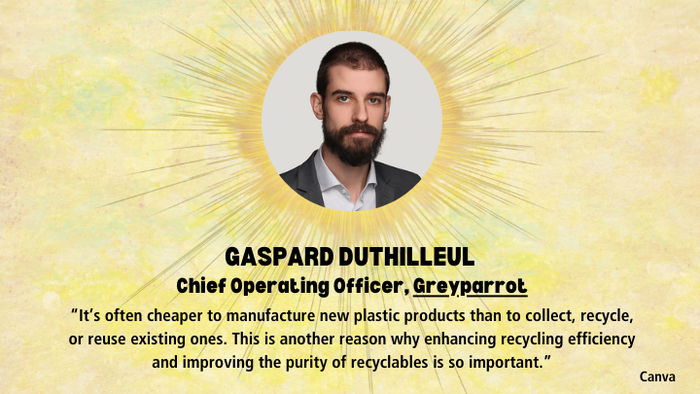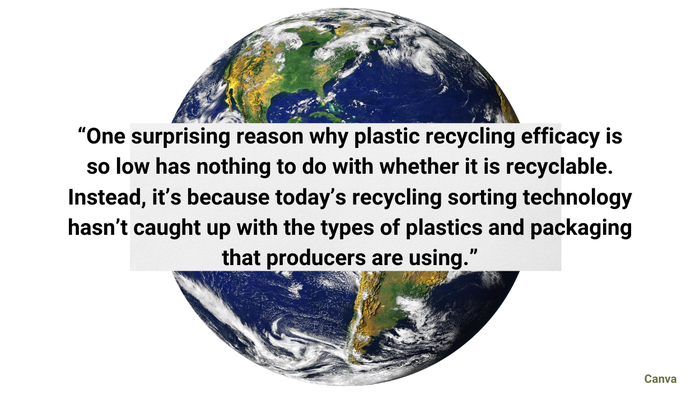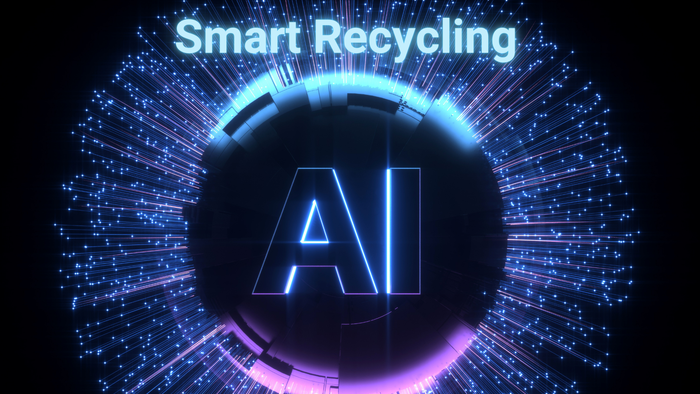Planet vs. Plastics: Not All Plastic Problems Are the Same
A focus on three core areas and four polymers will minimize the environmental impact of plastic and microplastics now and in the long term.

At a Glance
- Improving recycling efficiency and the purity of recyclables is critical.
- Investigate polymer recycling for sustainable, longer-lasting solutions.
- Implement AI in sorting technology to optimize recycling processes.
Earth Day’s focus this week is on the planet versus plastics, with organizers stating their goal for the Earth to reduce plastic use by 60% by 2040. There’s little doubt that we are in a plastic waste crisis. Driven by our quick consumption culture, which has only increased since online orders skyrocketed during the pandemic. More than 350M metric tons of plastic waste is generated per year. Without any changes in consumption or policies, plastic waste will triple by 2060, when more than one billion metric tons of plastic waste will be brought into the world.
At an item level example, more than 500 billion plastic bags were produced worldwide last year, which equates to one million bags produced per minute. In the US alone, over 100 billion plastic beverage containers — that’s 300+ bottles per resident — were sold last year. The vast majority will never be made into new plastic bottles, as 95% of all plastics in the US is not recycled.
That lack of circularity is contributing to the mounting climate crisis. But it’s far more complex than saying our planet is at war with plastics.
Plastic, of course, offers a lot of versatility in packaging that other materials, such as glass or aluminum, don’t offer. That versatility leads to a lot of different shapes of plastic packaging, which can make it harder to sort and recycle. Furthermore, moving away from some plastics can lead to worse impacts on sustainability. For instance, the abandonment of easily recycled high-density polyethylene (HDPE) milk containers in favor of composite cartons ended up being far less recoverable and had a bigger impact on the environment. Why? Because cartons were wrongly perceived to be more environmentally friendly.
Regardless of the reason, if plastic waste isn’t recycled, it’s most likely sent to landfills or burned, the latter of which adds 16 million tons of greenhouse gas to the atmosphere. Another 1.7 million tons of plastic waste enters the world’s oceans. Those pieces of plastic along with resulting microplastics pose a hazard to ocean life as plastic breaks down and slowly contaminates our oceans.

RICK LINGLE/CANVA
While the need to address these environmental impacts is clear, reducing plastic use by 60% over the next 15 years will be far from easy. Radically improving the current 5-6% plastic recycling rate should be a starting point. I recommend we focus on these three core areas to minimize the impact of our plastic use on the Earth both now and in the long term.
Core 1: focus on single-use plastics.
The International Negotiating Committee on Plastic Pollution (INC) has set an ambitious target to halt single-use plastic production by 2030 through the Global Plastics Treaty. Rapidly phasing out the use of single-use plastics, such as plastic and polystyrene food and beverage containers, bottles, straws, cups, cutlery, and disposable plastic bags, is a real obtainable goal. Prevention of material use, after all, is the most effective action towards sustainable waste management.
However, transitioning producers away from single-use plastics also presents significant challenges. The good news is that extended producer responsibility (EPR) bills are gaining traction. Already passed in Maine, Colorado, Oregon, and California, these bills aim to hold manufacturers financially accountable for their products' entire lifecycle, including collection, recycling, and disposal. The hope is that they will incentivize producers to adopt more sustainable practices and materials.
But we must also make the financial equation make sense to producers. It’s often cheaper to manufacture new plastic products than to collect, recycle, or reuse existing ones. This is another reason why enhancing recycling efficiency and improving the purity of recyclables is so important. Policymakers must enact legislation that makes it financially advantageous to use recycled materials over virgin ones.
That said, it’s important to acknowledge that for certain critical industries like healthcare, single-use plastics are a necessity. Banning avoidable single-use plastics, like straws, cups, food containers, and disposable bags, can help offset the unavoidable use of plastics in the short term.
Core 2: probe the recycling of polymers.
Outside of single use plastics, the second biggest challenge our Earth is facing with plastics is polymers that break down into microplastics. Polymers come in multiple forms, but four are the most used. One is HDPE, which is used for yogurt tubs, shampoo bottles, and of course milk jugs. Two others are low-density polyethylene (LDPE), which is used in shopping bags or bread bags, and PET, which is used in beverage bottles or microwavable food trays. The fourth is polypropylene, which is used in most food containers.
These plastics can break down into microplastics, but it’s important to note that not all polymers degrade into microplastics. In fact, liquid polymers such as polyurethanes have shown that they don’t turn into microplastics. Examining more uses of these types of polymers will be important in the years ahead.
A second major challenge with polymer-based recyclables is their short recycling lifespan. When plastic is recycled, the polymer chain is shortened, which means it can only be recycled a limited number of times. This is vastly different from glass or aluminum, which can be recycled continuously without a loss of quality.

RICK LINGLE/CANVA
With that in mind, next-generation recycling processes are needed to produce longer-lasting recyclables and ensure the recyclability of all polymers. Pyrolysis is one approach to breaking down polymers into their original chemicals, with the result being recycled material that is as high of a quality as plastic produced for the first time. This approach also allows the recycling of a broader number of polymers, including those traditionally considered non-recyclable due to contamination or complex compositions.
However, chemical recycling requires significant investment in infrastructure and technology to scale up production and ensure environmental sustainability. Further research and development are also needed to optimize it as a viable recycling method.
Core 3: improve recycling sorting technology.
One surprising reason why plastic recycling efficacy is so low has nothing to do with whether it is recyclable. Instead, it’s because today’s recycling sorting technology hasn’t caught up with the types of plastics and packaging that producers are using. For instance, the prevalent black plastic trays used frequently for food deliveries is almost always unsortable within legacy recycling facilities as they cannot identify it. Many of these facilities sort plastics by sending a beam of light at them. Because black plastic absorbs light, it is unsorted and never makes it into a recycling stream; instead, it goes to a local landfill.

RICK LINGLE/CANVA
Fortunately, new artificial intelligence technologies for into next-generation material recovery facilities (MRFs) are beginning to address the problem by capturing real-time images from cameras installed over conveyor belts. This approach is now being used to finally recycle black plastics and many other newer packaging.
Even better, once captured, data from the AI identification allows waste managers to analyze material by mass in the overall waste stream. This permits distinguishing specific polymers, tracking the material’s financial value, and projecting the potential greenhouse gas emissions. As a result, MRFs not only have access to 100% of the waste material data, but they can also receive actionable insights. This enables MRFs to refine their operations, streamline recycling efforts, and make the overall process more economically and environmentally viable.
This rich “waste intelligence” can be a catalyst for a more sustainable relationship between the planet and plastics. Recycling facility managers have insights that they can share up the packaging value chain so that producers can make data-driven decisions that are indeed better for the environment.
About the Author(s)
You May Also Like




